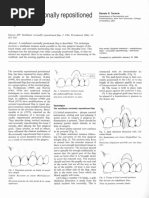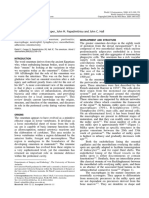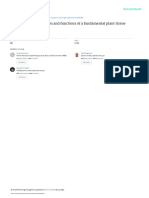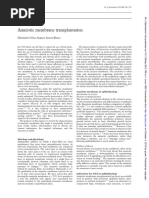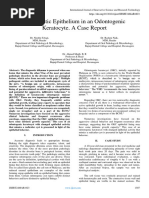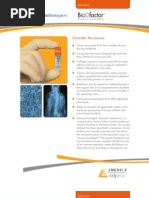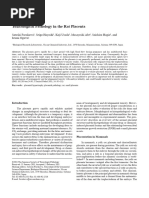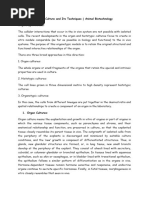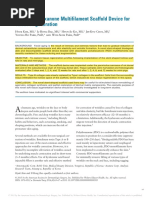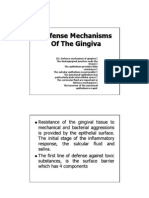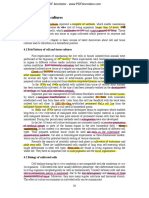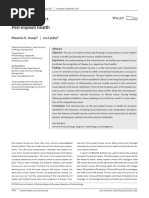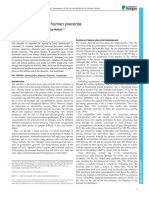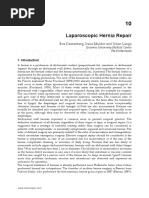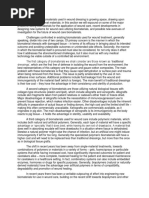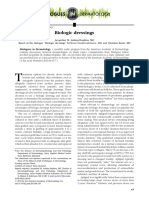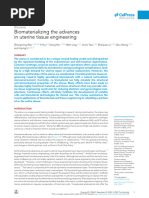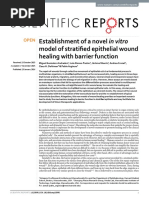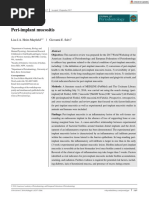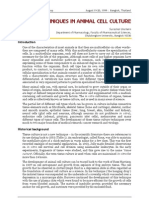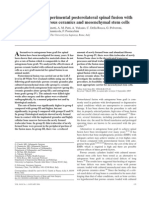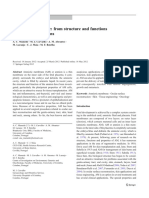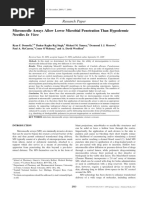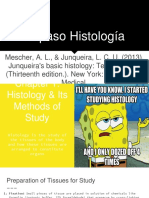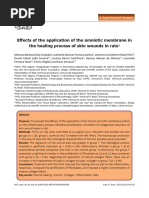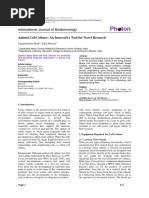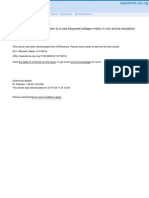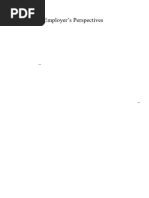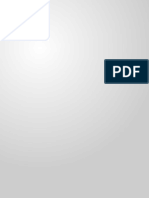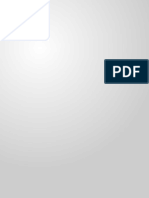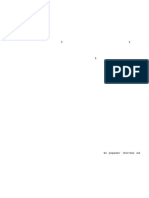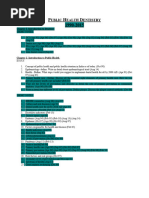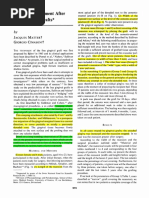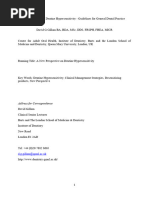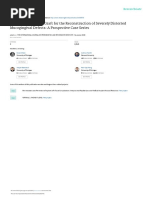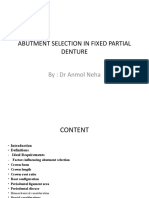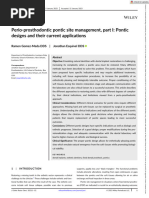Mother Touch in Periodontal Therapy: Chorion Membrane
Mother Touch in Periodontal Therapy: Chorion Membrane
Copyright:
Available Formats
Mother Touch in Periodontal Therapy: Chorion Membrane
Mother Touch in Periodontal Therapy: Chorion Membrane
Original Title
Copyright
Available Formats
Share this document
Did you find this document useful?
Is this content inappropriate?
Copyright:
Available Formats
Mother Touch in Periodontal Therapy: Chorion Membrane
Mother Touch in Periodontal Therapy: Chorion Membrane
Copyright:
Available Formats
Volume 8, Issue 6, June – 2023 International Journal of Innovative Science and Research Technology
ISSN No:-2456-2165
Mother Touch in Periodontal Therapy:
Chorion Membrane
1. Dr. Ankita Sharma (POST GRADUATE STUDENT) ; 2. Dr. Shailendra S. Chauhan (H.O.D)
3. Dr. Aditya Sinha(PROFESSOR) ; 4. Dr. Satendra Sharma(READER)
5. Dr. Vineeta Gupta(READER) ; 6.Dr. Radha Kumari (post graduate student )
Dept. of Periodontology and Oral Implantology, K.D Dental College and Hospital, Mathura, Uttar Pradesh, India
Abstract:- Periodontal regeneration is an old idea that is of the amniotic sac. The amnion is separated from the
evolving because to the adoption of more modern and decidua and the maternal uterus by the chorionic membrane,
altered barrier membranes to get better clinical results. which is joined to the exterior of the amniotic membrane.3-4
The placental amnion and chorion membranes are
examples of these membranes. Its biocompatibility and Throughout pregnancy, amniotic fluid, which is
capacity to speed up wound healing led to its initial contained in the sac created by the foetal membranes,
use.As part of guided tissue regeneration and guided surrounds the human foetus. It's crucial to remember that the
bone regeneration, the membrane has been utilised in chorion and amnion are both entirely composed of foetal
periodontology to reduce probing pocket depth, raise tissue. It is very likely that some amniotic fluid is transferred
clinical attachment levels, and encourage bone directly from the foetus through its membranes to the uterus
formation. Since these membranes are biologic, they can or placenta. A relatively recent development in dentistry,
be broken down by the body and work with tissue.It has placenta allografts saw the release of their first commercial
also been utilised to treat intrabony abnormalities, product in 2008. The distinct inherent biologic properties of
guided bone regeneration, and root covering therapies. placenta allografts facilitate wound healing and may spread
The special characteristics of this membrane that make regeneration.
it ideal for periodontal surgery, together with the clinical
repercussions and literature evaluation. II. HISTORICAL BACKGROUND
Keywords:- Periodontitis, Periodontal Therapy, Biologic For almost 70 years, human foetal membranes have
Membrane, Chorion Membrane, Periodontal Regeneration. been employed successfully in a variety of applications. In
1910, Davis reported the first use of foetal membrane in skin
I. INTRODUCTION transplantation.Stern described the use of human foetal
membrane to restore wounded and ulcerated skin surfaces in
Periodontitis is an inflammatory disease of the 1913.5De Rith was the first to report on the usage of foetal
supporting tissues of the teeth produced by individual germs membranes in the ocular surface in 1940. He treated
or groups of microbes that causes progressive destruction of conjunctival diseases with fresh aminion and chorion as a
the periodontal ligament and alveolar bone, resulting in biological dressing material. Kim and Tseng (1995)
periodontal pockets, gingival recession, or both.1 identified the most effective method for retaining the
Periodontal therapy can restore inflamed gingiva to near- biologic features of membranes. The prominence of the
normal condition. Surgical and non-surgical treatment foetal membrane has been attributed to a number of causes.
options are available based on the severity of the periodontal For starters, it lowers scarring and inflammation while also
disease. In cases of severe periodontitis and a few cases of speeding up wound healing. Second, its antibacterial
intermediate periodontitis that do not respond to non- properties function as scaffold for cell proliferation and
surgical treatment, surgical intervention is used. Periodontal differentiation. Third, the extracellular matrix and its
therapy's primary purpose is to repair, regenerate, or restore components, such as growth factors, imply that it is a
damaged tissues.2Regeneration is the process through which biomaterial that is well-suited for use as a native scaffold in
the body's architecture is naturally renewed through the tissue engineering. Finally, it is simple to obtain, process,
proliferation and differentiation of newly formed cells and and transport.
intercellular molecules. The repair only replaces the
original. The restoration simply replaces the wounded root III. THE STRUCTURE OF THE CHORION
surface's natural sulcus at the same level as the periodontal
pocket. Because the periodontal apparatus is produced by The amnion on the inside and the maternal decidua on
regeneration via selective cell repopulation, it is desirable to the outside are in contact with the chorion, the outermost of
repair it.1 the two foetal membranes. While "outer" refers to the area
or layer closest to the myometrium, "inner" refers to the
The amnion, the innermost of the two human foetal region or layer closest to the amniotic cavity. The placenta is
membranes, comes into contact with the amniotic fluid, the made of chorion, which is composed of hypertrophied
foetus, and the umbilical cord as well as other components chorion frondosum villi. In histological sections, the
IJISRT23JUN1071 www.ijisrt.com 2013
Volume 8, Issue 6, June – 2023 International Journal of Innovative Science and Research Technology
ISSN No:-2456-2165
chorionic villi that run the length of the chorion (chorion portions of Asia, most notably China, Korea, and Japan,
laeve) atrophy and appear as obliterated or ghost villi. There there was no record of its therapeutic usefulness. There was
are four stages in the non-placental chorion. These originate an increase in research on human placental extract after his
from within: description. Filatov began researching human cornea
Cellular Layer grafting using the theory of preserved material
Reticular Layer transplantation. He established that when animal or
Pseudo-basement Membrane vegetable tissues are detached from the organism and
Trophoblast subjected to external environments, they undergo a
metabolic readjustment. elements that impede their critical
Cellular layer functions. As a result, the tissues start producing substances
A thin layer made up of an interlacing network of that encourage critical functions. Filatov, 8-9named these
fibroblasts. When assessed at term, it is commonly defective substances "biogenic." stimulators.
or totally absent from the chorion. It is, however, simpler to
detect in the early stages of pregnancy. Human chorion membrane is a biological graft with
distinct biologic properties that can reduce inflammation,
Reticular Layer eliminate adhesions and scarring, control angiogenesis, and
This makes up the vast majority of the chorion's improve wound healing 10-11. Chorion membrane promotes
thickness and is made up of a reticular network with parallel epithelialization, maintains appropriate epithelial
fibres. Collagens I, III, IV, V, and VI make form the reticular phenotypes, and possesses antimicrobial capabilities.
network. Nodes can be found on the branching of the fibres.
There are a few fibroblasts and Hofbauer cells (single Anti scarring property
nucleated macrophages). Fibroblasts are naturally responsible for scar formation
during wound healing, and they are driven by transforming
Pseudo-basement Membrane growth factor, which is secreted in the wound area by
This is the trophoblast's foundation membrane. It is a macrophages and fibroblasts,12
dense layer of argyrophil connective tissue that connects to
the reticular layer above and sends anchoring and branching Chorion membrane Promotion of epithelialization
fibres down into the trophoblast. The basement membrane The chorion membrane Chorion membrane supports
uses collagen IV, fibronectin, and laminin to connect the epithelial cell mobility, basal cell adhesion, epithelial
trophoblasts to the reticular layer. differentiation, epithelial apoptosis, and epithelialization
during wound healing.Growth factors produced by the
Trophoblast chorion membrane, such as keratinocyte growth factor, basic
The chorion's deepest layer is made up of 2 to 10 layers fibroblast growth factor, and transforming growth factor B,
of trophoblast cells that are in contact with maternal decidua can promote epithelialization. Because of its high
on their deeper side. This stratum contains destroyed concentration of laminin-5, mitogenic growth factors, and
chorionic villi. anti-inflammatory proteins, chorion membrane promotes
epithelial cell proliferation, migration, adhesion, and
IV. COMPOSITION OF HUMAN CHORION differentiation. Because laminin has a high affinity for
MEMBRANE: binding epithelial cells,13 unlike prior reported membranes,
this barrier enables for rapid epithelial cell expansion rather
Fibronectin, laminins, and collagen types I, III, IV, V, than exclusion." Its basement membrane provides a secure
and VI are extracellular matrix (ECM) proteins present in and appropriate environment for the growth of epithelial
chorion. These ECM proteins are essential for chorion tissue cells. When compared to other synthetics, its high
biocompatibility5. Collagen is highly tolerated and permeability enables. In comparison to other synthetics, its
bioabsorbable, has hemostatic properties, and encourages high permeability enables for optimal oxygenation of
autogenous connective tissue (CT) migration close to it. epithelial cells: (HGF) that reduces scarring by maintaining
Fibronectin is involved in many biological processes, a proper TGF-1 and TGF-3 equilibrium. 14-15 It also reduces
including tissue healing, blood coagulation, cell migration, the risk of fibrosis by reducing fibroblasts' expression of
and adhesion."" also includes platelet-derived growth factor transforming growth factor and its receptor. As a result, the
AA (PDGF-AA), transforming growth factor B (TGF-B), chorion membrane regulates wound healing by encouraging
keratinocyte growth factor (KGF), vascular endothelial tissue regeneration over scar formation. Fibronectin also
growth factor (VEGF), and basic fibroblast growth factor (b- inhibits myofibroblast differentiation.
FGF), as well as interleukin (IL)-4, 6, 8, and 10, and tissue
inhibitor of metalloproteinase 1 and 2. (TIMP 1 and 2) Anti-inflammatory property
which promote periodontal regeneration, 6-7 It is hypothesised that the membrane, by functioning as
a barrier, prevents the influx of inflammatory cells and, as a
Properties of membrane: result, inflammatory mediators to the wound area. In the
Professor VP Filatov, a Russian ophthalmologist, chorion membrane, mesenchymal stem cells (MSCs) inhibit
outlined the synthesis of placental extract in the Principle of a variety of immune cell inhibitors, including secretory
Therapeutic Tissue. Prior to Filatov's inquiry, despite the fact leukocyte proteinase inhibitor and elafin. 16-17 Many
that it had been used for over a century in Europe and inhibitors have antibacterial properties in addition to anti-
IJISRT23JUN1071 www.ijisrt.com 2014
Volume 8, Issue 6, June – 2023 International Journal of Innovative Science and Research Technology
ISSN No:-2456-2165
inflammatory properties.They function as innate immune membrane collagen fibres prevents hematoma formation in
system components, protecting related surfaces against clean surgical wounds. This minimises bacterial burden and
infection. illness risk by preventing germ buildup. In addition, the
chorion membrane expresses two low-molecular-mass
Lack of immunogenicity elastase inhibitors, secretory leukocyte proteinase inhibitor
The chorion membrane, which is made up of trophoblast (SLPI) and elafin." Elafin and SLPI, in addition to their anti-
cells, has a distinct molecular surface architecture and inflammatory activities, contain antibacterial capabilities
biochemical properties that make it immune to maternal and operate as components of the innate immune system to
immune attack. HLA-G expression appears to be the most protect associated surfaces against infection. 17
critical factor in preventing trophoblast rejection. Non-
polymorphic class I molecules, including HLA-G, are The antimicrobial activity of MSCs in the foetal
expressed in extra-villous cytotrophoblast as well as amnion membrane is achieved by two mechanisms: directly through
cells and amniotic fluid, in contrast to HLA-A and B class I the secretion of antimicrobial factors such as LL-372, and
genes, which are down regulated in human trophoblast cells. indirectly by the production of immunomodulatory factors
The highly polymorphic classical class I molecules HLA-A, that upregulate bacterial death and phagocytosis by immune
B, and C are responsible for generating a specific immune cells.27
response by presenting peptide antigens to T cells. HLA-G,
on the other hand, is thought to have a role in the induction Cell Differentiation Property
of immunological tolerance by acting as a receptor. Because Foetal placental tissues have the ability to differentiate
the chorion membrane is derived from foetal tissue, all of into various cell lineages. The hematopoietic lineage can be
the preceding qualities apply. found in the chorion, allantois, and yolk sac, whereas the
mesenchymal lineage can be found in the chorion and
Chorion cells do not exhibit HLA-A, -B, -D, or -DR amnion. Because they have these features, cells isolated
antigens on their cell surfaces, but they do express HLA-G, from the chorion are good sources of hematopoietic and
implying that severe rejection would not occur following mesenchymal lineages.28
transplantation.18-20These mesenchymal stem cells vary from
other nucleated mammalian cells in that they exhibit limited The human placenta's foetal membranes contain
allogenic response when supplied to MHC mismatched adult stromal/mesenchymal tissue at the point of contact between
immunological competent recipients. 21 Membrane also has the trophoblastic area of the chorion and the amniotic
immunomodulatory effects on CD86 and CD40 in the epithelial layer. Bailo et al. (2004) identified amniotic and
presence or absence of Interferon-Y (IFN-Y). Furthermore, chorionic membrane mesenchymal stem cells (MSCs). The
because they lack the expression of co-stimulatory cell absence of haematological and endothelial markers, as well
surface molecules like CD80, they actively reduce T cell, as the expression of CD29, CD44, CD73, CD105, and
dendritic cell, and B cell function, which inhibits excessive CD166, are widely accepted phenotypic hallmarks of
inflammation. Although the immunogenicity of the foetal placenta-derived mesenchymal cells.22CMCs can
membrane is debatable, it is widely assumed that it is not differentiate into the osteocytic, chondrocytic, and
immunogenic. Furthermore, it is widely assumed that adipocytic mesodermal lineages, showing the existence of
cryopreserved foetal membrane tissue has lower mesenchymal progenitors. Interestingly, placenta-derived
immunogenicity than fresh foetal membrane tissue and that mesenchymal cells can also generate neuron-like cells,
cryopreserved cells are nonviable. Tissue grafts made of implying that this tissue contains cells capable of
placental membrane components are deemed to have undergoing both mesodermal and ectodermal lineage
"immune privilege" since they pose a minimal risk of development. Foetal mesenchymal placental cells have the
immunological rejection. 22-23 following morphological characteristics:The morphological
features of fetal mesenchymal placental cells include plastic
Antimicrobial and Antiviral Properties adherence and fibroblast-like growth. Portmann-Lanz et al.
Because of its antibacterial and antiviral capabilities, (2006) have reported that cells from amniotic and chorionic
foetal membrane reduces the risk of infection.24 Kjaergaard mesenchyme undergo cell death after four or five passages,
et al25 2001 shown that the amnion and chorion exhibit CD271 can be used as marker in placenta-derived
antibacterial properties in vitro against specific pathogens. mesenchymal cells to isolate populations with high
The presence of cystatin E, an analogue of cysteine clonogenic and osteogenic potential,29
proteinase inhibitor, contributes to its antiviral activities.
Chorion membrane (CM) has a strong antibacterial impact Plastic adhesion and fibroblast-like development are
because it produces human beta-defensins (hBD) and forms two morphological characteristics of foetal mesenchymal
an early physiologic "seal" with the host tissue, acting as a placental cells. Cells from amniotic and chorionic
physical barrier against the external environment. The mesenchyme die after four or five passes, according to
membrane binds securely to the wound via fibrin and elastin Portmann-Lanz et al. (2006), and CD271 can be utilised as a
connections, sealing the wound and preventing infection. marker in placenta-derived mesenchymal cells to identify
This strong adherence aids in the restoration of lymphatic populations with significant clonogenic and osteogenic
integrity, protects circulating phagocytes from exposure, and potential,29
allows for the faster elimination of pathogens. 10
Furthermore, the hemostatic feature of chorion basement
IJISRT23JUN1071 www.ijisrt.com 2015
Volume 8, Issue 6, June – 2023 International Journal of Innovative Science and Research Technology
ISSN No:-2456-2165
39-40
Additionally, chorion membrane-derived MSCs (CM- 10, .The anti-inflammatory capabilities of chorion
MSCs) suppress allogeneic immunological responses. MSCs membrane may be due to the synergistic effects of both the
modulate immune function primarily through soluble scaffold's inherent anti-inflammatory cytokines and the
substances such as transforming growth factor beta (TGF- scaffold itself. The consequences of recruited progenitors.41
B), 250 hepatocyte growth factor (HGF), 30 prostaglandin E2
(PGE), and 31 indoleamine 2, 3 dioxygenases (IDO). These The nature of the biocompatibility and healing capacity
substances released by placenta-derived MSCs may decrease of the chorion membrane may be linked in part to the
immune cell proliferation and inflammatory cytokine presence of growth factors and TIMP-1 in the chorion
production: 25-32Furthermore, cell-cell interaction is a basement membrane.4 Laminin is a glycoprotein
putative mechanism influencing immunological regulation. heterotrimer that consists of an a-chain, a B-chain, and a y-
33
Cell-to-cell communication, one of the proposed chain. There are five types of a-chains, three types of B-
mechanisms behind MSC immunomodulatory effects is the chains, and three varieties of y-chains. At least 15 different
interaction between MSCs and lymphocytes. Cell-cell types of laminin result from different combinations of these
interaction between bone marrow-derived MSCs (BM- chains.42 Laminin-5 promotes cell adherence on the cell
MSCs) and lymphocytes increased transcription of IL-10 membrane's surface via integrin-mediated attachment. This
and TGF-B in BM-MSCs. Furthermore, cell adhesion property of lammin-5 is most likely responsible for gingival
molecules such B7-H1, intercellular adhesion molecule-1 tissue's capacity to tightly adhere to membrane and then heal
(ICAM-1) and vascular cell adhesion molecule-1 (VCAM-1) and cling to the enamel surface,"
may play a role in immunological regulation.24Human
umbilical cord-derived MSCs (hUC- MSCs) modulate V. SOURCE OF CHORION TISSUE
immunity mostly through cell-cell interaction via adhesion
molecules, particularly B7-H134 Chorion donors must be living mothers who have had a
live child by caesarean section or vaginal section. Elective
Accelerated wound healing caesarean delivery helps in the choice of a willing donor and
Inflammation, proliferation, and remodelling are three the planned collection of chorion membrane because
overlapping stages in the complex biological process of placentas collected after natural vaginal delivery may have
normal wound healing. 35Neovascularization, stromal structural defects caused by the membrane stretching during
deposition, and epithelialization are the results of this labor and delivery and may be infected by normal vaginal
process, which involves the coordinated interaction of flora, herpes, chlamydia, or other contaminant bacteria.
several cell types, is fueled by extracellular matrix Different nations' tissue transplantation regulations require
interactions, and cytokine production. Mesenchymal stromal different procedures for preservation, testing, and storage
cells (MSCs) and hematopoietic progenitor cells (HPCs) due to the risk of infection with the human
have been proven to aid in wound healing. creating immunodeficiency virus (HIV) and hepatitis C. Virus
paracrine factors that stimulate angiogenesis, extracellular transmission protection is impacted by donor choice and
matrix formation, and tissue regeneration while promoting serological testing for known transmissible viruses at the
cell migration and proliferation. As a result, these cell types time of donation. three to four months later, this period of
have drawn a lot of attention for use in applications related time eliminates any potential for infection spread that could
to wound healing 37-38 be found later.,20
Two broad strategies for therapeutic application of A. Processing of Fetal Membrane
stem cells in chronic wounds are For clinical use of the membrane, it can be prepared in
(1) direct introduction of autologous or cryopreserved the following forms:
allogeneic stem cells to the wound and 1. Fresh membrane
(2) recruiting endogenous stem cells to the wound and 2. Dried membrane
increasing their wound healing capability are two major 3. Frozen membrane
techniques for therapeutic application of stem cells in 4. Freeze derived irradiated
chronic wounds. 5. Cryopreserved membrane
The human chorion membrane is in charge of attracting B. Advantages of Chorion Membrane:
endogenous progenitor cells to the wound. It contains a 1. It offers a different method for enhancing the recruitment
number of growth factors and cytokines and has been found and engraftment of endogenous progenitor cells that can
to increase fibroblast and endothelial cell proliferation as hasten wound healing and neovascularization. This
well as the recruitment of MSCs. encourage the expression eliminates the need for commercially available
of growth factors in native cells and stimulate peri matrix cryopreserved allogeneic progenitor cells.
neovascularization, while their structural component serves 2. It does not require special storage or shipping because it is
as a scaffold for tissue regeneration 14 MSCs have also been stable at room temperature.
shown to control immunological and inflammatory 3.It is an angiogenesis-promoting scaffold that draws
responses during wound healing. These progenitor cells progenitor cells to wounds.41
often decrease pro-inflammatory cytokine secretion, such as 4. It may work in tandem with recruited cells to reduce
tumour necrosis factor-a and interferon-y, while increasing inflammation.
anti-inflammatory cytokine production, such as IL-4 and IL-
IJISRT23JUN1071 www.ijisrt.com 2016
Volume 8, Issue 6, June – 2023 International Journal of Innovative Science and Research Technology
ISSN No:-2456-2165
5. Because this allograft self-adheres, there is no need for X. PERIODONTAL THERAPY WITH CHORION
suturing, making it easier to utilise in posterior lesions. MEMBRANES
6. The presence of considerable levels of laminin and
laminin-5 across the barrier is crucial due to their strong Chorion membrane is an immunotolerant
affinity for binding gingival cells. Epithelial cells may help semipermeable membrane that can guide tissue
to improve root surface adaptability. regeneration. It fulfils the mechanical GTR concept, which
7. It is a surgical patch that is immunologically compatible has been expanded to incorporate the biology GTR concept.
and used for a variety of medical purposes. The biomechanical GTR membrane promotes healing by
8. The chorion membrane (CM) functions as a barrier decreasing surgical scarring and functional loss while
membrane between the gingival epithelium and hard tissue, simultaneously serving as a food source. Another advantage
encouraging periodontal ligament cells to become progenitor is that the amniotic membrane is better revascularized. It has
cells capable of regenerating new tissues. the potential to be a fantastic grafting material. It has been
9. CM is available in a variety of lengths and widths, shown to improve wound healing, postoperative function,
allowing for adaptation at the site on both the buccal and and aesthetics while offering no dangers. 45 In guided bone
lingual aspects of the quadrant in a single strip with regeneration, a treatment approach for large bony
interdental trimming. abnormalities, a barrier membrane is employed to stimulate
10. After being placed dry, the barrier quickly becomes osteogenesis while inhibiting fibroblast cell multiplication.
hydrated by blood, becoming incredibly pliable and closely Lyophilized multi-layered acellular human collagen was
mimicking the characteristics of the underlying surface. used to cure rat tibia deformities in vivo. It acted as a barrier
11. Carly wound stability is provided by CM when utilised against the invasion and formation of fibrous tissue while
as an internal fixation. Furthermore, it has a thin, self- also encouraging bone growth.46
adherent character.
A barrier membrane is used in directed bone
VI. PLACENTAL MEMBRANE APPLICATIONS regeneration, a therapy strategy for major bony defects, to
BASED ON THEIR QUALITIES INCLUDE induce osteogenesis while suppressing fibroblast cell
VII. growth. In vivo, lyophilized multi-layered acellular human
1. The physical properties of foetal membrane have collagen was used to treat rat tibia abnormalities. An implant
demonstrated that it is compatible with the corneal surface fixture requires 1mm of bone to surround it in dental implant
of the eye. Because the immunological modulatory powers therapy, and the site preservation technique is used to
of the ocular and placental membranes are so similar, they accomplish this. A resorbable amnion chorion membrane
have been nicknamed "parallel universes" 44 was used as a site preservation barrier. Placental allografts
2. Human foetal membrane is also used as a suitable have immunoprivileged properties, are antibacterial and
dressing, with four main goals in mind: haemostasis, water antimicrobial, help to reduce wound inflammation, and are
loss reduction through evaporation, providing a moist permanent.47
environment for cell survival and proliferation, acting as a
barrier to microbial colonisation, and pain reduction. Amnion chorion membrane, demineralized freeze-
3. Foetal membrane is recognised as an important possible dried bone allograft (DFDBA), and xenograft are used to
source of scaffolding material that must swiftly integrate repair intrabony lesions.48 Improved root coverage, tissue
with host tissue and provide an ex (HSV), varicella zoster thickness, and gingival tissue connection. Provides excellent
virus-infected tissues, and erythema multiforme major. cosmetic outcomes while causing little post-operative
Dental applications include: discomfort or negative effects. Because of its self-adhering
1. Surgical methods for root coverage," nature, processed dehydrated allograft amnion is appropriate
2. Periodontal pocket treatment with guided tissue for multi teeth operations and recession anomalies. It can be
regeneration used to treat shallow to moderate Miller's Class I and II
3. Vestibular augmentation recession defects instead of autograft tissue. 45
VIII. LIMITATIONS The exposed root surface is intended to be hidden
IX. through periodontal plastic surgery. Recent research has
1. The use of foetal membranes requires skill; so, operator revealed a resorbable amniotic membrane that supports
inexperience is one restriction. 10 gingival wound healing and acts as a rich source of stem
2. The risk of spreading an infection during a transplant of cells in addition to maintaining the morphological and
foetal membranes never goes away. It is important to follow anatomical structure of regenerated tissues. A relatively
particular safety guidelines and precautions when using recent development in periodontal plastic surgery is this
these biological membranes. amnion tissue-based allograft.48
3. Both the procedure and the defect morphology influence
how these membranes are used. This method demands XI. CONCULSION
expert understanding of periodontal regeneration and wound
healing. Amnion and chorion membranes, for example, offer
antibacterial, biocompatible, and antiangiogenic qualities
that have made them desirable in the field of periodontal
regeneration in recent years. They have long worked in the
IJISRT23JUN1071 www.ijisrt.com 2017
Volume 8, Issue 6, June – 2023 International Journal of Innovative Science and Research Technology
ISSN No:-2456-2165
medical industry, and they are currently expanding into [15]. 15 .Gupta I, Gupta R, Gokhale ST, Sharma A. Placental
other branches of dentistry. Their surgical application has a tissues: fixing smiles. Int J Innov Scientific Res
number of benefits. They have drawbacks, just as other 2014;7(1):57-62.
inventions. However, they might be changed in the future to [16]. 16. Ruoslahti E. Fibronectin. J Oral Pathol 1981;10:3-
increase clinical efficacy. 13.
[17]. 17 King AE, Critchley HOD, Sallenave J-M, Kelly
REFERENCES RW. Elafin in human endometrium: an antiprotease and
antimicrobial molecule expressed during menstruation.
[1]. Newman MG, Takei H, Klokkevold PR, Carranza FA. J Clin Endocrinol Metab 2003;88(9):4426-31.
Carranza's clinical periodontology. Elsevier health [18]. 18 Kanyshkova TG, Buneva VN, Nevinsky GA.
sciences; 2011 Feb 14. Lactoferrin and its biological functions. Biochemistry
[2]. Ausenda F, Rasperini G, Acunzo R, Gorbunkova A, (Mosc) 2001;66(1):1-7.
Pagni G. New perspectives in the use of biomaterials [19]. 19 . Sargent IL. Maternal and fetal immune responses
for periodontal regeneration. Materials. 2019 during pregnancy. Exp Clin Immunogenet
Jan;12(13):2197. 1993;10(2):85-102
[3]. Oyen ML, Cook RF, Calvin SE. Mechanical failure of [20]. 20 Parolini O, Alviano F, Bagnara GP, Bilic G, Bühring
human fetal membrane tissues. J Mater Sci Mater Med HJ, Evangelista M, et al. Concise review: isolation and
2004;15(6):651-8. characterization of cells from human term placenta:
[4]. 4.Chua WK, Oyen ML. Do we know the strength of outcome of the first international workshop on placenta
the chorioamnion? A critical review and analysis. Eur J derived stem cells. Stem Cells 2002;26(2):300-11.
Obstet Gynecol Reprod Biol 2009;144(Suppl 1):S128– [21]. 21 Ilancheran S, Moodley Y, Manuelpillai U. Human
33. fetal membranes: a source of stem cells for tissue
[5]. Hodde J. Naturally occurring scaffolds for soft tissue regeneration and repair? Placenta 2009;30(1):2-10.
repair and regeneration. Tissue Eng 2002;8(2):295-308. [22]. 22.Bailo M, Soncini M, Vertua E, Signoroni PB,
[6]. Steinberg AD, LeBreton G, Willey R, Mukherjee S, Sanzone S, Lombardi G, et al. Engraftment potential of
Lipowski J. Extravascular clot formation and platelet human amnion and chorion cells derived from term
activation on variously treated root surfaces. J placenta. Transplantation 2004; 78(10):1439-48.
Periodontol 1986;57(8):516-22, [23]. 23 Hori J, Wang M, Kamiya K, Takahashi H,
[7]. 7.Ruoslahti E. Fibronectin. J Oral Pathol 1981;10:3-13. Sakuragawa N. Immunological characteristics of
[8]. 8. Koob TJ, Lim JJ, Massee M, Zabek N, Denozière G. amniotic epithelium. Cornea 2006;25(10 Suppl 1):S53-
Properties of dehydrated human amnion/chorion 8.
composite grafts: Implications for wound repair and [24]. 24 .Streilein JW. Unraveling immune privilege.
soft tissue regeneration. J Biomed Mater Res B Appl Science 1995;270(5239):1158-59,
Biomater 2014;102(6):1353-62. [25]. 25 .Whitsett CF, PriestJH, Priest RE, Marion J. HLA
[9]. 9. Filatov VP. Tissue therapy. LeMédecin Généraliste typing of cultured amniotic fluid cells. Am J Clin
de France 1951;11(1):3-5. Pathol 1983;79(2):186-94.
[10]. 10. Solomon A, Wajngarten M, Alviano F, Anteby I, [26]. 26 . Kjaergaard N, Hein M, Hyttel L, Helmig RB,
Elchalal U, Pe'er J, et al. Suppression of inflammatory Schonheyder HC, Uldbjerg N, et al. Antibacterial
and fibrotic responses in allergic inflammation by the properties of human amnion and chorion in vitro. Eur J
amniotic membrane stromal matrix. Clin Exp Allergy Obstet Gynecol Reprod Biol 2001;94(2):224-9.
2005;35(7):941- [27]. 27 .Talmi YP, Sigler L, Inge E, Finkelstein Y, Zohar Y.
[11]. 11.Tseng SC, Li DQ. Ma X. Suppression of Antibacterial properties of human amniotic
transforming growth factor-beta isoforms, TGF-beta membranes. Placenta 1991;12(3):285-8
receptor type II, and myofibroblast differentiation in [28]. 28 .Gupta A, Kedige SD, Jain K. Amnion and chorion
cultured human corneal and limbal fibroblasts by membranes: potential stem cell reservoir with wide
amniotic membrane matrix. J Cell Physiol applications in periodontics. Int J Biomater 2015:1-9.
1999;179(3):325-35. [29]. 29 . Soncini M, Vertua E, Gibelli L, Zorzi F, Denegri
[12]. 12.Robson MC, Krizek TJ, Koss N, Samburg JL. M, Albertini A, et al. Isolation and characterization of
Amniotic membranes as a temporary wound dressing. mesenchymal cells from human fetal membranes. J
Surg Gynecol Obstet 1973;136(6):904-6. Tissue Eng Regen Med 2007;1(4):296-305
[13]. 13 Velez I, Parker WB, Siegel MA, Hernandez M. [30]. 30 . Di Nicola M, Carlo-Stella C, Magni M, Milanesi
Cryopreserved amnioticmembrane for modulation of M, Longoni PD, Matteucci P, et al. Human bone
periodontal soft tissue healing a pilot study. J marrow stromal cells suppress T-lymphocyte
Periodontol 2010;81(12):1797-804. proliferation induced by cellular or nonspecific
[14]. 14 Koob TJ, Lim JJ, Massee M, Zabek N, Denozière mitogenic stimuli. Blood 2002;99(10):3838-43.
G. Properties of dehydrated human amnion/chorion [31]. 31.Plumas J, Chaperot L, Richard MJ, Molens JP,
composite grafts: Implications for wound repair and Bensa JC, Favrot MC. Mesenchymal stem cells induce
soft tissue regeneration. J Biomed Mater Res B Appl apoptosis of activated T cells. Leukemia
Biomater 2014;102(6):1353-62 2005;19(9):1597-604.
[32]. 32. Li C, Zhang W, Jiang X, Mao N. Human-placenta-
derived mesenchymal stem cells inhibit proliferation
IJISRT23JUN1071 www.ijisrt.com 2018
Volume 8, Issue 6, June – 2023 International Journal of Innovative Science and Research Technology
ISSN No:-2456-2165
and function of allogeneic immune cells. Cell Tissue as a barrier membrane for guided bone regeneration.
Res 2007;330(3):437-46. Langmuir. 2015 Aug 11;31(31):8642-53.
[33]. 33. Kang JW, Koo HC, Hwang SY, Kang SK, Ra JC, [50]. 47.21. Chen E, Tofe A. A literature review of the safety
Lee MH, et al. Immunomodulatory effects of human and biocompatibility of amnion tissue. J ImplAdvClin
amniotic membrane-derived mesenchymal stem cells. J Dent. 2010;2(3):67-75.
Vet Sci 2012;13(1):23-31. [51]. 48.22. Kothiwale SV, Anuroopa P, Gajiwala AL. A
[34]. 34 . Tipnis S, Viswanathan C, Majumdar AS. clinical and radiological evaluation of DFDBA with
Immunosuppressive properties of human umbilical amniotic membrane versus bovine derived xenograft
cord-derived mesenchymal stern cells: role of B7-HI with amniotic grade II furcation defects. Cell and tissue
and IDO. Immunol Cell Biol 2010;88(8):795-806. banking. 2009 Nov 1;10(4):317
[35]. 35.Gurtner GC, Werner S, Barrandon Y, Longaker MT.
Wound repair and regeneration. Nature
2008;453(7193):314-21
[36]. 36. Suga H, Rennert RC, Rodrigues M, Sorkin M,
Glotzbach JP. Januszyk M, et al. Tracking the elusive
fibrocyte: identification and characterization of
collagen producing hematopoietic lineage cells during
murine wound healing. Stem Cells 2014;32(5):1347-
60.
[37]. 37 .Salibian AA, Widgerow AD, Abrouk M, Evans GR.
Stem cells in plastic surgery: a review of current
clinical and translational applications. Arch Plast Surg
2013;40(6):666-75
[38]. 38 . Rennert RC, Sorkin M, Garg RK, Gurtner GC.
Stem cell recruitment after injury: lessons for
regenerative medicine. Regen Med 2012;7(6):833-50.
[39]. 39. Newman RE, Yoo D, LeRoux MA, Danilkovitch-
Mingkova A. Treatment of inflammatory diseases with
mesenchymal stem cells. Inflamm Allergy Drug
Targets 2009:8(2):110-23.
[40]. 40 . Singer NG, Caplan AL. Mesenchymal stem cells:
mechanisms of inflammation. Annu Rev Pathol
2011:6:457-78
[41]. 41 .Maan ZN, Rennert RC, Koob TJ, Januszyk M, Li
WW, Gurtner GC. Cell recruitment by amnion chorion
grafts promotes neovascularization. J Surg Res
2015;193(2):953-62.
[42]. 42.Takashima S, Yasuo M, Sanzen N. Characterization
of laminin isoforms in human amnion. Tissue Cell
2008;40(2):75-81.
[43]. 43. Kinumatsu T, Hashimoto S, Muramatsu T, Sasaki
H, Jung H-S, Yamada S, et al. Involvement of laminin
and integrins in adhesion and migration of junctional
epithelium cells. J Periodont Res 2009;44(1):13-20
[44]. 44. Niederkorn JY, Wang S. Immune privilege of the
eye and fetus, parallel universes? Transplantation
2005;80(9):1139-44.
[45]. 45. Malak TM, Bell SC. Structural characteristics of
term human fetal membranes: a novel zone of extreme
morphological alteration within the rupture site. Br J
Obstet Gynaecol 1994;101(5):375-86.h wide
applications in periodontics. Int J Biomater 2015:1-9.
[46]. 45.Mohan R, Bajaj A, Gundappa M. Human amnion
membrane: potential applications in
[47]. oral and periodontal field. Journal of International
Society of Preventive &
[48]. Community Dentistry. 2017 Jan;7(1):15
[49]. 46.20. Li W, Ma G, Brazile B, Li N, Dai W, Butler JR,
Claude AA, Wertheim JA, Liao J, Wang B.
Investigating the potential of amnion-based scaffolds
IJISRT23JUN1071 www.ijisrt.com 2019
You might also like
- Semilunar Coronally Repositioned FlapDocument5 pagesSemilunar Coronally Repositioned FlapTarun Kumar Bhatnagar100% (1)
- Review Article: Amnion and Chorion Membranes: Potential Stem Cell Reservoir With Wide Applications in PeriodonticsDocument10 pagesReview Article: Amnion and Chorion Membranes: Potential Stem Cell Reservoir With Wide Applications in PeriodonticsElissa IsdasariNo ratings yet
- Liu 2018Document15 pagesLiu 2018raden chandrajaya listiandokoNo ratings yet
- Salud PeriimplantarDocument7 pagesSalud PeriimplantarCarina AidetNo ratings yet
- WJG 6 169 PDFDocument8 pagesWJG 6 169 PDFJaldo FreireNo ratings yet
- Epidermis The Formation and Functions of A FundameDocument24 pagesEpidermis The Formation and Functions of A FundameIqbal BilgramiNo ratings yet
- Amiotic Membrane TransplantDocument5 pagesAmiotic Membrane TransplantKhor Hui DiNo ratings yet
- Metaplastic Epithelium in An Odontogenic Keratocyte. A Case ReportDocument3 pagesMetaplastic Epithelium in An Odontogenic Keratocyte. A Case ReportInternational Journal of Innovative Science and Research TechnologyNo ratings yet
- 10 1016@j WNDM 2020 100190Document16 pages10 1016@j WNDM 2020 100190yanuararipratama89No ratings yet
- Technological Institute of The PhilippinesDocument8 pagesTechnological Institute of The PhilippinesJohn Dolph FacundoNo ratings yet
- Biod Biodfactor FlyerDocument2 pagesBiod Biodfactor Flyerapi-235072265No ratings yet
- 24_95Document17 pages24_95M. RizkyNo ratings yet
- Organ Culture and Its Techniques (1)Document8 pagesOrgan Culture and Its Techniques (1)nishagraj5No ratings yet
- MÔ DA in vitro (1)Document19 pagesMÔ DA in vitro (1)hyhyhyNo ratings yet
- IJABMR-6-54Document3 pagesIJABMR-6-54vrbcncb9gbNo ratings yet
- Kim2016 Pdo MultifilamenDocument5 pagesKim2016 Pdo Multifilamenyolanda tejaNo ratings yet
- Cal33 - Culturre ConditiosDocument42 pagesCal33 - Culturre Conditiostrhd9hx9g9No ratings yet
- Polymers 03 00509 v2Document18 pagesPolymers 03 00509 v2Branko BabicNo ratings yet
- Guided Tissue RegenerationDocument131 pagesGuided Tissue Regenerationt sNo ratings yet
- Microsoft PowerPoint - Defense Mechanisms of The Gingiva (Compatibility MDocument19 pagesMicrosoft PowerPoint - Defense Mechanisms of The Gingiva (Compatibility MDon Vigis AbrahamNo ratings yet
- Cell and Tissue CulturesDocument5 pagesCell and Tissue CulturesJessa Nicole ReteracionNo ratings yet
- Cells 09 00368 v2Document111 pagesCells 09 00368 v2Turtle ArtNo ratings yet
- Peri Implant Health: Mauricio G. Araujo - Jan LindheDocument7 pagesPeri Implant Health: Mauricio G. Araujo - Jan LindheCristian CulcitchiNo ratings yet
- Development of The Human PlacentaDocument14 pagesDevelopment of The Human PlacentasaanrusoNo ratings yet
- Role of Tissue Engineering in Oral and Maxillofacial Reconstruction: Findings of The 2005 AAOMS Research SummitDocument8 pagesRole of Tissue Engineering in Oral and Maxillofacial Reconstruction: Findings of The 2005 AAOMS Research SummitRam MohanNo ratings yet
- Laparoscopic Hernia Repair: Eva Deerenberg, Irene Mulder and Johan LangeDocument25 pagesLaparoscopic Hernia Repair: Eva Deerenberg, Irene Mulder and Johan LangeKamran AfzalNo ratings yet
- Biological Prosthetics For Hernia Repair: EditorialDocument2 pagesBiological Prosthetics For Hernia Repair: EditorialtexveerNo ratings yet
- Research Essay - Materials in Wound HealingDocument4 pagesResearch Essay - Materials in Wound HealingJosh ChiuNo ratings yet
- Ijos 201375 ADocument4 pagesIjos 201375 AIsmail YusufNo ratings yet
- Biologic Dressings: Jjunkin1@jhmi - EduDocument3 pagesBiologic Dressings: Jjunkin1@jhmi - EduEsq. Nelson OduorNo ratings yet
- Laparoscopic Hernia Repair: Eva Deerenberg, Irene Mulder and Johan LangeDocument24 pagesLaparoscopic Hernia Repair: Eva Deerenberg, Irene Mulder and Johan LangebapNo ratings yet
- Biomaterializing Advances in UterineDocument16 pagesBiomaterializing Advances in UterinealumnogustaNo ratings yet
- Basic Science Review of Birth Tissue Uses in OphthDocument10 pagesBasic Science Review of Birth Tissue Uses in OphthPatricia Chirinos SaldañaNo ratings yet
- Dr. Wasim PathanDocument3 pagesDr. Wasim PathanwasimNo ratings yet
- L. Pereira - Embryology - Updates and Highlights On Classic Topics (2012, Intech)Document222 pagesL. Pereira - Embryology - Updates and Highlights On Classic Topics (2012, Intech)Katy ANo ratings yet
- OpTechSportsMed - 2017 - Friel - Amniotic Fluid - Cells - and Membrane ApplicationDocument5 pagesOpTechSportsMed - 2017 - Friel - Amniotic Fluid - Cells - and Membrane ApplicationJacob DoughertyNo ratings yet
- Structure and in Vitro Cytocompatibility of The Gastropod Shell of Helix PomatiaDocument8 pagesStructure and in Vitro Cytocompatibility of The Gastropod Shell of Helix PomatiaBesMaNo ratings yet
- Amniotic Membrane: From Structure and Functions To Clinical ApplicationsDocument24 pagesAmniotic Membrane: From Structure and Functions To Clinical ApplicationsLim Xian NioNo ratings yet
- Establishment of A Novel in Vitro Model of Stratified Epithelial Wound Healing With Barrier FunctionDocument9 pagesEstablishment of A Novel in Vitro Model of Stratified Epithelial Wound Healing With Barrier FunctionBaladika muda28No ratings yet
- Methods To Study Differences in Cell Mobility During Skin Wound Healing in VitroDocument30 pagesMethods To Study Differences in Cell Mobility During Skin Wound Healing in VitroSachinNo ratings yet
- Ri Cucci 2006Document11 pagesRi Cucci 2006Bofeet TinsaNo ratings yet
- Intl J Gynecology Obste - 2023 - Clark - Dehydrated Human Amniotic Membrane and Amniotic Fluid Allograft For TheDocument3 pagesIntl J Gynecology Obste - 2023 - Clark - Dehydrated Human Amniotic Membrane and Amniotic Fluid Allograft For TheUrología GinecológicaNo ratings yet
- Journal of Periodontology - 2018 - Heitz Mayfield - Peri Implant MucositisDocument10 pagesJournal of Periodontology - 2018 - Heitz Mayfield - Peri Implant MucositisFrancisca Cardenas OñateNo ratings yet
- Cell Culture HandbookDocument30 pagesCell Culture HandbookRamasamy VelmuruganNo ratings yet
- Experimental Posterolateral Spinal Fusion With Porous Ceramics and Mesenchymal Stem CellsDocument8 pagesExperimental Posterolateral Spinal Fusion With Porous Ceramics and Mesenchymal Stem CellsccsloureiroNo ratings yet
- Te Bao Dong VatDocument8 pagesTe Bao Dong VattramNo ratings yet
- Struktur AmnionDocument12 pagesStruktur AmnionnurulNo ratings yet
- J Tissue Eng Regen Med - 2022 - Louvrier - Development of A Biomimetic Bioreactor For Regenerative Endodontics ResearchDocument10 pagesJ Tissue Eng Regen Med - 2022 - Louvrier - Development of A Biomimetic Bioreactor For Regenerative Endodontics ResearchPedro AfonsoNo ratings yet
- Membrana Amniotica PDFDocument256 pagesMembrana Amniotica PDFLeslyNo ratings yet
- Microneedle Arrays Allow Lower Microbial Penetration Than Hypodermic Needles in VitroDocument10 pagesMicroneedle Arrays Allow Lower Microbial Penetration Than Hypodermic Needles in VitroAgustina TNo ratings yet
- Repaso Histologi ADocument132 pagesRepaso Histologi AMichael Rivera MoralesNo ratings yet
- Chronic Peritoneal Dialysis AccessDocument11 pagesChronic Peritoneal Dialysis AccessMimi MuhammidaNo ratings yet
- Effects of The Application of The Amniotic Membrane in The Healing Process of Skin Wounds in RatsDocument12 pagesEffects of The Application of The Amniotic Membrane in The Healing Process of Skin Wounds in Ratsyanuararipratama89No ratings yet
- Karina Teja Putri A Critical Review On The PotentialDocument7 pagesKarina Teja Putri A Critical Review On The Potentialpablouanl17No ratings yet
- Kheili Mohemtar 3Document19 pagesKheili Mohemtar 3Rana Sabouni TabariNo ratings yet
- (Taju) Animal Cell Culture An Innovative Tool For Novel ResearchDocument7 pages(Taju) Animal Cell Culture An Innovative Tool For Novel ResearchDr. TajamulNo ratings yet
- Guided Tissue RegenerationDocument7 pagesGuided Tissue RegenerationElenaLazarNo ratings yet
- Posterior Commissure of The Human Larynx Revisited PDFDocument8 pagesPosterior Commissure of The Human Larynx Revisited PDFLilia ScutelnicNo ratings yet
- Chaudhry 2006Document7 pagesChaudhry 2006aidah.fitriyah-2023No ratings yet
- 2011 Ghanaati Et Al Mucograft GerDocument13 pages2011 Ghanaati Et Al Mucograft GerDaniel E XêniaNo ratings yet
- The Dental Pulp: Biology, Pathology, and Regenerative TherapiesFrom EverandThe Dental Pulp: Biology, Pathology, and Regenerative TherapiesNo ratings yet
- The Impact of Price, Facilities and Experience in Maintaining the Sustainable Loyalty of Air Asia Passengers Using Satisfaction as a Mediating VariableDocument11 pagesThe Impact of Price, Facilities and Experience in Maintaining the Sustainable Loyalty of Air Asia Passengers Using Satisfaction as a Mediating VariableInternational Journal of Innovative Science and Research Technology100% (1)
- Business Employer’s Perspectives on Hiring Former Persons Deprived of Liberty in the City of Angeles, PhilippinesDocument25 pagesBusiness Employer’s Perspectives on Hiring Former Persons Deprived of Liberty in the City of Angeles, PhilippinesInternational Journal of Innovative Science and Research TechnologyNo ratings yet
- AI-Driven Algorithms: Transforming Customer Engagement with AI and Ethical Data PrivacyDocument9 pagesAI-Driven Algorithms: Transforming Customer Engagement with AI and Ethical Data PrivacyInternational Journal of Innovative Science and Research TechnologyNo ratings yet
- Phenotypic Diversity Assessment and Related Indigenous Knowledge of Yam (Dioscorea spp) in Ebonyi State, NigeriaDocument112 pagesPhenotypic Diversity Assessment and Related Indigenous Knowledge of Yam (Dioscorea spp) in Ebonyi State, NigeriaInternational Journal of Innovative Science and Research TechnologyNo ratings yet
- Sustainability in Alcohol Production: An Overview of Green Initiatives and their Impact on the IndustryDocument5 pagesSustainability in Alcohol Production: An Overview of Green Initiatives and their Impact on the IndustryInternational Journal of Innovative Science and Research TechnologyNo ratings yet
- Facial Expression-Based Emotion Detection for Adaptive Teaching in Educational EnvironmentsDocument7 pagesFacial Expression-Based Emotion Detection for Adaptive Teaching in Educational EnvironmentsInternational Journal of Innovative Science and Research TechnologyNo ratings yet
- Functionality of Google Maps and Parameter-based Efficient Eateries route DetectionDocument8 pagesFunctionality of Google Maps and Parameter-based Efficient Eateries route DetectionInternational Journal of Innovative Science and Research TechnologyNo ratings yet
- Spam Detection Using Large Datasets with Multilingual SupportDocument7 pagesSpam Detection Using Large Datasets with Multilingual SupportInternational Journal of Innovative Science and Research TechnologyNo ratings yet
- Effect of Forms and Shapes on Acoustical Quality of Ecclesiastical Buildings in NigeriaDocument10 pagesEffect of Forms and Shapes on Acoustical Quality of Ecclesiastical Buildings in NigeriaInternational Journal of Innovative Science and Research Technology100% (1)
- Application of Gestalt Theory in Interior Design Dinas Perpustakaan Dan Kearsipan Daerah Provinsi Jawa Barat (DISPUSIPDA)Document10 pagesApplication of Gestalt Theory in Interior Design Dinas Perpustakaan Dan Kearsipan Daerah Provinsi Jawa Barat (DISPUSIPDA)International Journal of Innovative Science and Research TechnologyNo ratings yet
- Enhancing Biogas Yield by Co-Digestion of Cattle Dung and Acha (Digitaria Exilis) HullsDocument8 pagesEnhancing Biogas Yield by Co-Digestion of Cattle Dung and Acha (Digitaria Exilis) HullsInternational Journal of Innovative Science and Research TechnologyNo ratings yet
- Climate Adaptation and Capturing Innovative and Best Practices of Sudan Funded Projects for Knowledge ManagementDocument6 pagesClimate Adaptation and Capturing Innovative and Best Practices of Sudan Funded Projects for Knowledge ManagementInternational Journal of Innovative Science and Research TechnologyNo ratings yet
- Next-Gen Talent Matching System: Innovating Recruitment with AI-Driven JD and CV MatchingDocument5 pagesNext-Gen Talent Matching System: Innovating Recruitment with AI-Driven JD and CV MatchingInternational Journal of Innovative Science and Research TechnologyNo ratings yet
- Nurses’ Knowledge Regarding Management of Burn Injury Patients at Selected Hospital in Dhaka, BangladeshDocument16 pagesNurses’ Knowledge Regarding Management of Burn Injury Patients at Selected Hospital in Dhaka, BangladeshInternational Journal of Innovative Science and Research TechnologyNo ratings yet
- Examining How Police as a Security Function Fosters Socio-Economic Development in KenyaDocument16 pagesExamining How Police as a Security Function Fosters Socio-Economic Development in KenyaInternational Journal of Innovative Science and Research TechnologyNo ratings yet
- A Field Survey to Investigate the Flora of Dharmashala Dhauladhar Range in North-Western Himalayan Region of IndiaDocument13 pagesA Field Survey to Investigate the Flora of Dharmashala Dhauladhar Range in North-Western Himalayan Region of IndiaInternational Journal of Innovative Science and Research TechnologyNo ratings yet
- Fatigue Failure Analysis of Notched Specimen with En19, En354 and En36c MaterialsDocument7 pagesFatigue Failure Analysis of Notched Specimen with En19, En354 and En36c MaterialsInternational Journal of Innovative Science and Research TechnologyNo ratings yet
- Adapting 'Rishi-Krishi' Perspectives in Safe Farming in Aadhikhola, Gandaki Province, NepalDocument10 pagesAdapting 'Rishi-Krishi' Perspectives in Safe Farming in Aadhikhola, Gandaki Province, NepalInternational Journal of Innovative Science and Research Technology100% (1)
- Chronic Low-Grade Systemic Inflammatory State and Insulin Resistance: Implications for Metabolic HealthDocument14 pagesChronic Low-Grade Systemic Inflammatory State and Insulin Resistance: Implications for Metabolic HealthInternational Journal of Innovative Science and Research TechnologyNo ratings yet
- Determinants of the Exploitation of Groundwater Resources of the Alluvial Plain of KarfiguelaDocument4 pagesDeterminants of the Exploitation of Groundwater Resources of the Alluvial Plain of KarfiguelaInternational Journal of Innovative Science and Research TechnologyNo ratings yet
- Exploring the Role of Human Behavior Analytics in Strengthening Privacy-Preserving Systems for Sensitive Data ProtectionDocument16 pagesExploring the Role of Human Behavior Analytics in Strengthening Privacy-Preserving Systems for Sensitive Data ProtectionInternational Journal of Innovative Science and Research TechnologyNo ratings yet
- Optimizing Maternal Nutrition and its Impact on Fetal Development: Evidence-Based Insights and Current GuidelinesDocument4 pagesOptimizing Maternal Nutrition and its Impact on Fetal Development: Evidence-Based Insights and Current GuidelinesInternational Journal of Innovative Science and Research TechnologyNo ratings yet
- Perception of Victim Blaming: Basis for Community EducationDocument6 pagesPerception of Victim Blaming: Basis for Community EducationInternational Journal of Innovative Science and Research TechnologyNo ratings yet
- Technological Innovations in Osteoporosis Diagnosis and their Implications for Bone Metastases Management in OncologyDocument15 pagesTechnological Innovations in Osteoporosis Diagnosis and their Implications for Bone Metastases Management in OncologyInternational Journal of Innovative Science and Research TechnologyNo ratings yet
- A Study at Bal Rugnalay in Paratwadha Maharastra to Provide Teaching Program Plan and to Assess Effectiveness of Non Nutritive Sucking or Pacifier in Promoting Physiologic Stability and Nutritional Status among Preterm Infants Admitted in NICUDocument7 pagesA Study at Bal Rugnalay in Paratwadha Maharastra to Provide Teaching Program Plan and to Assess Effectiveness of Non Nutritive Sucking or Pacifier in Promoting Physiologic Stability and Nutritional Status among Preterm Infants Admitted in NICUInternational Journal of Innovative Science and Research TechnologyNo ratings yet
- Aetiology of Hearing Loss in Cochlear Implantees: A Study of 191 Cases at CI Centre, CMH, DhakaISRT24DEC453Document6 pagesAetiology of Hearing Loss in Cochlear Implantees: A Study of 191 Cases at CI Centre, CMH, DhakaISRT24DEC453International Journal of Innovative Science and Research TechnologyNo ratings yet
- Optimising Web Application Development Using Ruby on Rails, Python, and Cloud-Based ArchitecturesDocument10 pagesOptimising Web Application Development Using Ruby on Rails, Python, and Cloud-Based ArchitecturesInternational Journal of Innovative Science and Research TechnologyNo ratings yet
- Perceived Cognitive Skills in Chemistry through Case-Based Learning ApproachDocument17 pagesPerceived Cognitive Skills in Chemistry through Case-Based Learning ApproachInternational Journal of Innovative Science and Research TechnologyNo ratings yet
- Effect of Nanotechnology in Orthodontic Materials : An OverviewDocument6 pagesEffect of Nanotechnology in Orthodontic Materials : An OverviewInternational Journal of Innovative Science and Research TechnologyNo ratings yet
- Estimation of Input Vector Pair from Embedded Space Vector Corresponding to the Framework Based on Spacer Component Matrices: A Constrained Optimization based ApproachDocument13 pagesEstimation of Input Vector Pair from Embedded Space Vector Corresponding to the Framework Based on Spacer Component Matrices: A Constrained Optimization based ApproachInternational Journal of Innovative Science and Research TechnologyNo ratings yet
- Dental RVU Cookbook: Washington State Health Care AuthorityDocument9 pagesDental RVU Cookbook: Washington State Health Care AuthorityPaul GNo ratings yet
- Perio EstheticsDocument39 pagesPerio EstheticsSamra NausheenNo ratings yet
- Examination Diagnosis and Treatment Planning (1) Complete DentureDocument11 pagesExamination Diagnosis and Treatment Planning (1) Complete DentureSyed NooraniNo ratings yet
- Sjögren Et AlDocument7 pagesSjögren Et Alplayer osamaNo ratings yet
- Public Health Dentistry - CompleteDocument11 pagesPublic Health Dentistry - CompleteramyaayokeshNo ratings yet
- Down Syndrome Research PaperDocument8 pagesDown Syndrome Research Paperapi-738493105No ratings yet
- When To Choose Which Retention Element To Use For Removable Dental ProsthesesDocument8 pagesWhen To Choose Which Retention Element To Use For Removable Dental ProsthesesStefanKaleTodorovicNo ratings yet
- OverdentureDocument227 pagesOverdentureEazhil RajNo ratings yet
- 1976 - Creeping Attachment After Free Gingival GraftDocument6 pages1976 - Creeping Attachment After Free Gingival GraftTien Li AnNo ratings yet
- J Clinic Periodontology - 2020 - Herrera - Adjunctive Effect of Locally Delivered Antimicrobials in Periodontitis TherapyDocument18 pagesJ Clinic Periodontology - 2020 - Herrera - Adjunctive Effect of Locally Delivered Antimicrobials in Periodontitis TherapyDr.Niveditha SNo ratings yet
- Eur J Dental Education - 2017 - Field - The Graduating European Dentist A New Undergraduate Curriculum FrameworkDocument9 pagesEur J Dental Education - 2017 - Field - The Graduating European Dentist A New Undergraduate Curriculum FrameworkHernández Becerra Ivanna PaolaNo ratings yet
- The Influence of Orthodontic Movement On Periodontal Tissues LevelDocument12 pagesThe Influence of Orthodontic Movement On Periodontal Tissues LevelMardiniuc Andra-LuciaNo ratings yet
- The Periodontal Pocket: Intended Learning OutcomesDocument4 pagesThe Periodontal Pocket: Intended Learning OutcomesREHAB ABBASNo ratings yet
- Biologic Width Evaluation and Correction of Its ViDocument7 pagesBiologic Width Evaluation and Correction of Its Visari elyNo ratings yet
- Symptomatic Apical Periodontitis Et Ology: Diagnosis and TreatmentDocument3 pagesSymptomatic Apical Periodontitis Et Ology: Diagnosis and TreatmentPrince AmiryNo ratings yet
- 1573461559111608Document17 pages1573461559111608Denis PopozogloNo ratings yet
- ADocument8 pagesAAmar BhochhibhoyaNo ratings yet
- Case Report - Extensive Dental Caries - HIV - Case ReportDocument6 pagesCase Report - Extensive Dental Caries - HIV - Case Reportwanda oktariaNo ratings yet
- Yutaro Kitanaka Article PDFDocument23 pagesYutaro Kitanaka Article PDFNay AungNo ratings yet
- 8 - Case Studies in Ultrasonic Debridement - Pocket DentistryDocument9 pages8 - Case Studies in Ultrasonic Debridement - Pocket DentistryRizki OktavianiNo ratings yet
- Gillam A New Perspective On Dentine Hypersensitivity 2017 AcceptedDocument24 pagesGillam A New Perspective On Dentine Hypersensitivity 2017 AcceptedNaoki MezarinaNo ratings yet
- Article 41 2Document10 pagesArticle 41 2Felix SchweppeNo ratings yet
- Abutment Selection in Fixed Partial DentureDocument37 pagesAbutment Selection in Fixed Partial Dentureanmol nehaNo ratings yet
- Davis 2014Document11 pagesDavis 2014Monica JohanaNo ratings yet
- Dra Gill Articulo 2 New Definicion Salud Oral2017Document4 pagesDra Gill Articulo 2 New Definicion Salud Oral2017Betsy QuispeNo ratings yet
- 2023 Perioprosthodontic Pontic Site Management Part I Pontic Designs and TheirDocument12 pages2023 Perioprosthodontic Pontic Site Management Part I Pontic Designs and Theirkatherina rozicNo ratings yet
- 10 Easy Ways To Manage and Treat Receding Gums NaturallyDocument5 pages10 Easy Ways To Manage and Treat Receding Gums Naturallybarney_bestNo ratings yet
- Physics in Orthodontics 05-25-21 EnglishDocument42 pagesPhysics in Orthodontics 05-25-21 EnglishMilton David Rios SerratoNo ratings yet
- finalOD April 2019 Clinical-New DiseaseDocument6 pagesfinalOD April 2019 Clinical-New Diseasewafiqah izzatul auliahNo ratings yet
